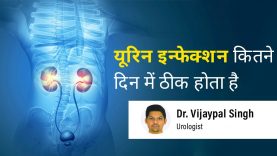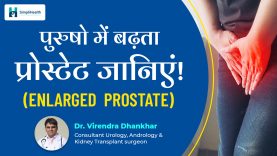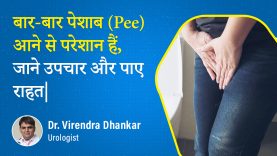Dr. Virendra Dhankhar
Dr. Virendra Dhankhar
Overactive Bladder(OAB): रात में बार बार पेशाब आने का क्या कारण है?
In this video SimpliHealth expert urologist Dr. Virendra Dhankhar will talk about a very important topic i,e Overactive Bladder(OAB). Also, he will answer some questions that people usually ask like:
- What is an overactive bladder?
- रात में बार बार पेशाब आने का क्या कारण है?
- How to diagnose overactive bladder?
- Primary OAB
- Secondary OAB
- Overactive bladder medication
- Overactive bladder treatment
What is an overactive bladder?
As the name suggests bladder is working more hence more urine. Due to an OAB, one may feel the need to frequent urination, sometimes patients urinate midway to the toilet or have to run to urinate.
Overactive Bladder types
There are two type of OAB:
- Primary Overactive Bladder
- Secondary Overactive Bladder
When it occurs without any reason, it is termed as primary whereas if there is an underlying mechanism, it is considered secondary.
Secondary OAB
Some common reasons for a secondary OAB are urine infection, stone in bladder or urethra, increase in the size of the prostate, urine incontinence, stricture, and any neurological reason. In the case of primary OAB, there is no underlying mechanism but it is seen that muscles may get thick, or due to some changes in nerve the structure of bladder is altered. The bladder is an elastic organ and has 2 functions: to store urine and to expel it. Due to its elastic nature, when urine is stored in the bladder no pressure is built up thereby kidney is preserved. During micturition, urine is expelled with full force. If this natural cycle is disturbed bladder becomes overactive.
How to diagnose overactive bladder?
Mainly it is diagnosed by the patient’s history and complaints; no other specific test is required. Few symptoms of OAB are urine frequency, urine urgency, urgent incontinence, and nocturia. It affects the patient in two ways: Dry and Wet. Wet OAB means urine is expelled before reaching the toilet hence termed as wet incontinence. In the case of Dry OAB, there is frequency and urgency of urine but is not expelled on the way to the toilet.
Usually, tests are performed to rule out the secondary causes. An ultrasound is performed to determine whether there is swelling in the kidney, further helping in the detection of stone in the bladder or ureter. It also checks the void volume after micturition and the size of the prostate. Urine culture is run to check the micro-examination of urine to omit the possibility of urine infection. Neurological tests can also be performed to check the dysfunction of nerves. If secondary symptoms are cured it may heal automatically.
Primary OAB
Now we will talk about the primary OAB. Since there is no underlying mechanism behind this, there are 2 methods to cure this. First is the use of medicine and the second is behavioural therapy. Both have the same effect on the body but if treated alone with drugs, it may get recurrent. So by modifying the patient lifestyle, it can be controlled and cured. Lifestyle modifications includes liquid intake: If taken in less quantity, it will concentrate urine ultimately irritating the bladder. Also, intake of a larger quantity, will automatically lead to an increase in the frequency of urination. Hence 2 -2.5 liters of water intake is a must for a day. Secondly, if the frequency of urine is more at the night then one should have minimum water intake after 5 pm.
It helps in improving the quality of life. Thirdly irritants like tea, coffee, and cigarettes must be avoided as they irritate the bladder thereby increasing the frequency and urgency of urine. There is no specific precaution to be taken in diet however if one notices that after consumption of some food symptoms increases or the frequency of urine is increased, that can be noted and avoided. Obesity may also lead to an OAB hence one must reduce the weight. Lastly is the biofeedback tactic and pelvic floor or kegel exercise. It helps by tightening the pelvic floor thereby controlling the urgency and frequency of urine. Any physiotherapist might be consulted for the same. In addition, medicine is prescribed to relax and to increase the capacity of the bladder to control the frequency and urgency.
Overactive Bladder Medication
Medicine prescribed may consist of one drug or it may be a combination of 2 drugs. A urologist may start one drug first followed by a second drug depending upon the symptoms. The treatment takes a span of 2-3 weeks to show its effect rather than in 2 -3 days. Also, it should be consumed for 3-6 months to have a longer effect. In severe cases where these drugs or combination and behavioural therapy doesn’t show their effect, Botox is inserted in the bladder to cure it however it is not the 1st line of treatment.
Primarily overactive bladder is treated with drugs and behavioural therapy. Overactive bladder is not a life-threatening disease rather it is a quality of life disease affecting the quality of life. It is more common in females rather than males. It can be easily controlled by drugs, behavioural therapy, and kegel exercise for long-term relief.















Comments (0)